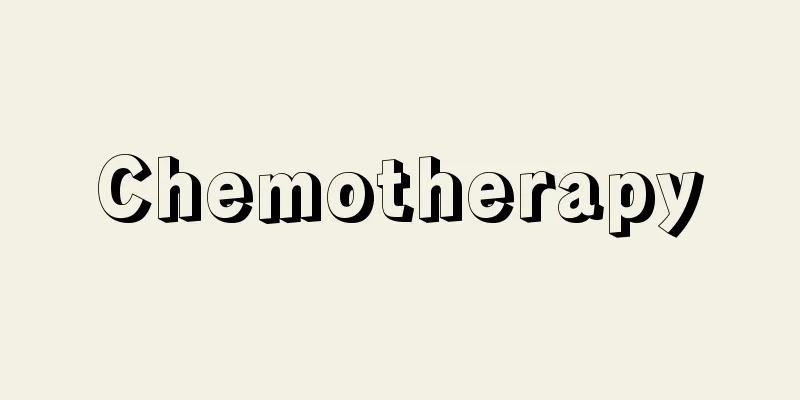Chemotherapy

|
It is a method of treating diseases by directly inhibiting the growth of or killing pathogenic parasites in the body using chemical substances. It is a type of drug therapy, but it is not a symptomatic treatment, but a causal treatment. [Noriaki Yanagishita] HistoryChemotherapy was founded by the German bacteriologist Ehrlich. In 1899, Ehrlich became director of the newly established National Institute of Experimental Therapy, and used hundreds of chemicals in animal experiments to investigate the relationship between chemicals and antibacterial properties. When Hata Sahachiro, who was studying abroad at the same institute, succeeded in infecting rabbits with syphilis, Ehrlich immediately ordered the administration of the aforementioned chemicals to observe their effectiveness. In 1909, he finally succeeded in treating syphilis with the 606th chemical, Salvarsan, and announced this the following year. Ehrlich is also known for systematizing chemotherapy academically, and his theories on efficacy coefficients and the mechanism of action of chemicals are still accepted today. In 1932, while researching bactericidal dyes, Domagk of Germany administered the recently discovered red dye Prontosil to mice that had become septic due to hemolytic streptococcus, and confirmed its remarkable effectiveness, announcing his findings in 1935. It was subsequently discovered that the true form of Prontosil's action was sulfanilamide, which is produced by the decomposition of the azo bond in the body, and in 1936 it was confirmed that the synthesized sulfamine had antibacterial properties. Furthermore, after sulfapyridine was successfully used to treat pneumonia in England in 1937, numerous sulfamine derivatives were synthesized one after another, leading to the emergence of many sulfa drugs. However, the number of sulfa drugs actually in use is extremely small compared to this number. Antibiotics came next, and were discovered in 1928. While researching influenza viruses, British chemist Fleming accidentally discovered that mold that had fallen from the air in a laboratory was growing in a Staphylococcus incubator, leaving the surrounding area sterile. He created an extract from the mold culture, and discovered that it inhibited the growth of Staphylococcus even when diluted 800 times, and named this substance penicillin. However, this extract was not a pure substance, and 10 years passed without its therapeutic effects being evaluated. In 1939-1940, British researchers Florey and Chain succeeded in extracting penicillin as a pure substance through joint research, and used it to treat streptococcal infections in animals. Penicillin first attracted attention in 1944, when it cured the pneumonia of then British Prime Minister Churchill, and was reported around the world as a miracle drug. In 1943, the American Waxman discovered streptomycin, and chemotherapy for tuberculosis began in 1945. Since then, much research and development has been carried out on antibiotics, making it easier to treat the causes of many infectious diseases, but at the same time, bacteria resistant to chemotherapy drugs have also appeared. This cycle of development of new chemotherapy drugs that are effective against these resistant bacteria, and the emergence of bacteria resistant to these new drugs, has continued to this day. Furthermore, chemotherapy is not limited to pathogenic parasites, and in recent years, there has also been active development of anti-cancer drugs (anti-cancer drugs). Generally, in the history of chemotherapy, the discovery of Salvarsan is referred to as the first period, the sulfa drug era as the second period, and the antibiotic era as the third period. [Noriaki Yanagishita] Chemotherapeutic agentsThis refers to chemical substances used in chemotherapy. In the narrow sense, chemotherapeutic agents refer to any synthetic chemical substance, excluding antibiotics, which are substances produced by microorganisms. However, as synthetic antibiotics have appeared, this distinction has become ambiguous, and now the term is often used in a broad sense to include antibiotics. Chemotherapeutic agents are characterized by being administered to target pathogens that infest the body, which differs from drugs used in general drug therapy, which utilize their pharmacological effects on the body. With chemotherapy agents, the effects on the body itself are considered side effects. Also, affinity for pathogens is considered effective, while affinity for the body's tissue cells is considered toxic, and the ratio of the two is called the chemotherapy coefficient. Chemotherapeutic agents have a selective toxicity, which indicates the range of efficacy of the agent; for example, selective toxicity means that the agent is effective only against gram-positive bacteria, or against both gram-positive and gram-negative bacteria. Chemotherapeutic agents always have an antibacterial spectrum, which indicates the extent to which the agent is effective or ineffective against certain bacterial species. Resistance to chemotherapeutic agents means that the pathogen itself is resistant, not that the body develops resistance to the drug. The mechanism is said to be related to the pathogen's genetic cell fusion and enzyme systems. There are two types of action of chemotherapeutic agents: bacteriostatic action, which only suppresses the growth of pathogens, and bactericidal action, which kills pathogens. Bacteriostatic action only inhibits growth, and pathogens do not grow but are not dead, so they may grow if the environment changes. Therefore, attention should be paid to the type of chemotherapeutic agent and its concentration, and the administration interval is an issue. Bacteriostatic agents need to be administered frequently with short administration intervals, but bactericidal agents take time to start growing again, so the administration interval can be long. In addition, the mechanism of action is listed as (1) inhibition of synthesis of the cell wall of pathogens, (2) changing the permeability of the cell wall, (3) inhibition of synthesis of proteins necessary for growth, (4) inhibition of synthesis of nucleic acids, and (5) metabolic antagonism. (1) and (2) cause bacteriolysis and have a bactericidal effect. (3) to (5) are growth inhibitors and have a bacteriostatic effect. [Noriaki Yanagishita] "Clinical Doctor" Vol. 7, No. 1 "Chemotherapy - Basics and Clinical Practice" (1981, Chugai Medical Publishing)" ▽ "Chemotherapy by Galil, translated by Tsukada Takashi (Hakusuisha, Kuseiju Bunko)" ▽ "Clinical Pharmacology Series 10: Chemotherapy Drugs by Mashimo Hiroaki et al. (1964, Nakayama Shoten)" Source: Shogakukan Encyclopedia Nipponica About Encyclopedia Nipponica Information | Legend |
|
化学物質を用いて生体内の病原寄生体に対し直接その増殖を阻害したり殺菌することによって疾患を治療する方法をいう。薬物療法の一種であるが、対症療法ではなく、原因療法の一つである。 [柳下徳雄] 沿革化学療法はドイツの細菌学者エールリヒによって創始された。1899年、新設の国立実験治療研究所の所長となったエールリヒは、数百に及ぶ化学物質を動物実験に用い、化学物質と抗菌作用の関連を追究していたが、留学中の秦(はた)佐八郎が同研究所で梅毒をイエウサギに感染させることに成功すると、ただちに前述の化学物質を投与して効果をみることを命じ、1909年、606番目の化学物質サルバルサンによってようやく梅毒の治療に成功、翌年これを発表した。また、エールリヒは化学療法を学問的に体系づけたことでも知られ、薬効係数や化学物質の作用機序などの理論は現在もなお認められている。 1932年に、殺菌性染料を研究中のドイツのドーマクは、発見されたばかりの赤色染料プロントジルを、溶血性連鎖球菌によって敗血症をおこさせたハツカネズミに投与して卓効のあることを確認し、35年に発表した。その後、プロントジルの作用の本態が、生体内でアゾ結合が分解して生ずるスルファニルアミドであることがわかり、36年には合成されたスルファミンに抗菌性のあることが確認された。さらに37年、イギリスでスルファピリジンが肺炎の治療に用いられて成功するに及んで、次々に多数のスルファミン誘導体が合成され、多くのサルファ剤が出現した。しかし、実際に使われているサルファ剤は、その数に比べてきわめて少ない。 ついで抗生物質が登場したが、その発見は1928年である。イギリスのフレミングはインフルエンザウイルスの研究中に、実験室内で空中から落下したアオカビがブドウ球菌の培養器内で増殖し、その周囲が無菌状態になっているのを偶然発見、アオカビの培養物のエキスをつくり、これを800倍に薄めてもブドウ球菌の増殖を抑制することをつきとめ、この物質をペニシリンと名づけた。しかし、このエキスは物質として純粋なものでなかったこともあり、治療効果の面では評価されないまま10年を経過した。39~40年、イギリスのフローリーとチェインらは共同研究の結果、ペニシリンを純粋な物質として抽出することに成功し、動物の連鎖球菌感染症を治療した。このペニシリンが注目されたのは44年、当時のイギリス首相チャーチルの肺炎を治し、奇跡の薬として全世界に報道されてからである。 また、1943年にはアメリカのワックスマンがストレプトマイシンを発見し、45年から結核の化学療法が始まった。以来、多くの抗生物質の研究開発が行われて、多くの感染症の原因療法が容易となったが、一方、化学療法剤に対する耐性菌も出現した。そして、この耐性菌にも有効な新しい化学療法剤の開発、それに対する耐性菌の出現、という繰り返しが現在まで続けられている。また、化学療法の対象は病原寄生体にとどまらず、近年は抗悪性腫瘍(しゅよう)剤(制癌(せいがん)剤)の開発も盛んに行われている。 一般に、化学療法史上では、サルバルサンの発見を第1期とし、サルファ剤時代を第2期、抗生物質時代を第3期と称している。 [柳下徳雄] 化学療法剤化学療法に用いられる化学物質をいう。狭義には、微生物が産生する物質である抗生物質を別にして、あくまで合成された化学物質をもって化学療法剤とするが、抗生物質にも合成されるものが出現して、この区別があいまいになり、現在では広義に抗生物質を含んでよばれることが多い。 化学療法剤は、生体に寄生する病原体を目標として投与されるのが特徴で、一般の薬物療法に用いられる薬剤が生体に対する薬理作用を利用しているのと異なる。化学療法剤では、生体そのものに対する作用は、副作用となる。また、病原体に対する親和性は効果であり、生体の組織細胞に対する親和性は毒性とみられ、両者の比を化学療法係数という。 化学療法剤には、その薬物に感受性のある病原体が決まっており、選択毒性という。これは効果の有効範囲を示すもので、グラム陽性菌のみに有効とか、グラム陽性菌と陰性菌の両方に有効といったことが選択毒性で、化学療法剤にはかならず有効な菌種や無効な菌種などの程度を示す抗菌スペクトルが示されている。また、化学療法剤の耐性は病原体そのものが耐性をもつことを意味し、生体がその薬物に対して耐性をもってくるのではない。その機序については、病原体の遺伝子の細胞融合や酵素系に関連するといわれる。 化学療法剤の作用には、病原体の発育を抑制するだけの静菌作用と、殺菌してしまう殺菌作用の二つがある。静菌作用は発育を阻害するだけであり、病原体は増殖しないが死んではいないので、環境の変化があれば増殖することがある。したがって、化学療法剤の種類やその濃度に留意すべきで、投与間隔が問題にされる。静菌性のものは投与間隔を短く、頻回に投与する必要があるが、殺菌性のものは再増殖を始めるまでに時間がかかるので、投与間隔は長くてもよい。また、作用機序については、(1)病原体の細胞壁の合成阻害、(2)細胞壁の透過性を変える、(3)増殖に必要なタンパク質の合成阻害、(4)核酸の合成阻害、(5)代謝拮抗(きっこう)、などがあげられている。(1)と(2)は溶菌をきたし、殺菌作用を示す。(3)~(5)の場合は増殖阻害作用であり、静菌作用を示す。 [柳下徳雄] 『『臨床医』7巻1号「化学療法――基礎と臨床」(1981・中外医学社)』▽『ガリル著、塚田隆訳『化学療法』(白水社・文庫クセジュ)』▽『真下啓明他著『臨床薬理学大系10 化学療法薬』(1964・中山書店)』 出典 小学館 日本大百科全書(ニッポニカ)日本大百科全書(ニッポニカ)について 情報 | 凡例 |
<<: Stoichiometry - stoichiometry
Recommend
cost planning
… However, recent cost management focuses not onl...
Attached organisms - Fuchakuseibutsu
A general term for organisms that live by attachin...
nairātmya-vāda (English spelling)
...The idea unique to Buddhism that there is no f...
highway
…Today, the term expressway, which is commonly us...
sāman (English spelling) saman
…It is a sacred text of Brahmanism, one of the fo...
Ephoros (English spelling)
[Born] 405 BC. Aeolis, Cyme [Died] 330 BCE An anci...
Glacial acetic acid
… [nature] It is a colorless liquid with a strong...
SOL - Sol
Occupation/Title singer nationality South Korea d...
Society for the Propagation of the Gospel in foreign parts
...The seemingly stable Church of England system ...
Anode Slime
… The gold contained in copper ore and in the sil...
Ali Qi - Ariki
… The names of famous local liquors during the Ta...
Zero-point vibration
In quantum mechanics, due to the uncertainty princ...
Ajita (English spelling) Ajita Kesakambalin (Kesakambala)
An Indian thinker from the 6th to 5th century BCE....
Three Swee Problem - Three Swee Problem
The term is used from the perspective of Danish hi...
All Saints Church
…It refers to the artistic style of the reign of ...









